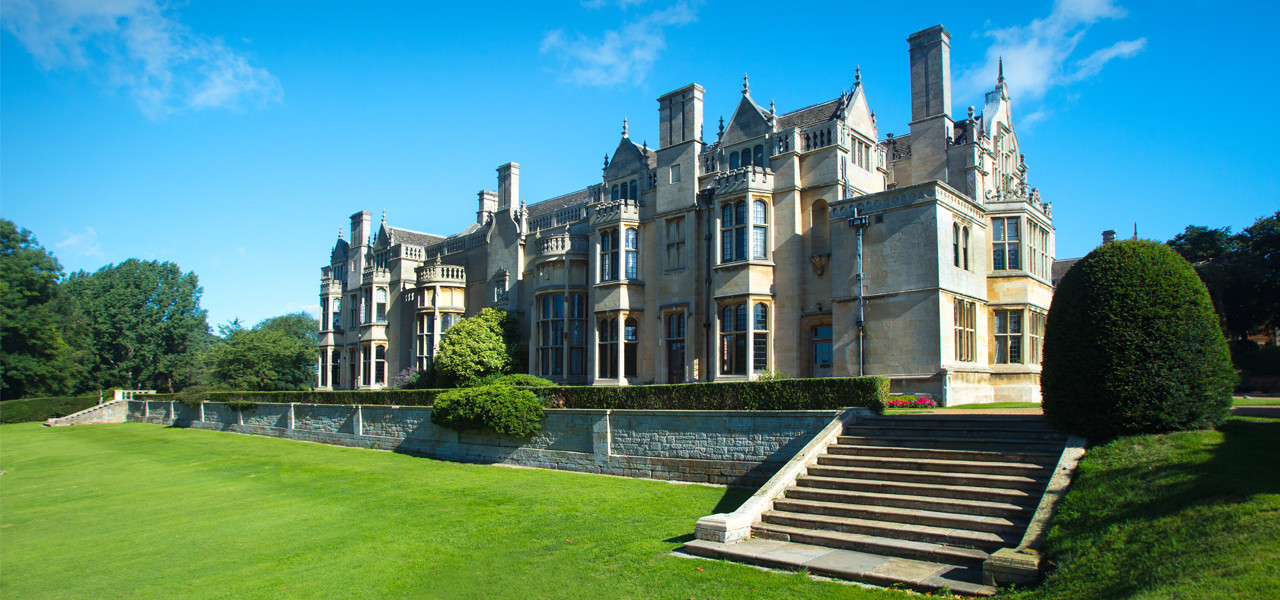Old Owners & Secrets of Rushton Hall
History and origins of Rushton Hall in Northampton
Toying with the idea of visiting Northamptonshire? Country hotel’s on par with Rushton are few and far between.
Tales of treachery, dedication, inspiration and innovation contribute to the beloved essence of our Grade I Listed house…
From the grandeur of the property as you approach, to the decadent details prevalent in every room, read on to discover more about the history of Rushton Hall.
Origins and Ownership
Many note upon arrival that Rushton is truly a magnificent structure.
Built mainly in local stone, it was commenced by Sir John Tresham and his family in 1438, who through generations owned the hall for nearly 200 years.
The family’s ownership also included the village known as Rushton St Peter, and as such the village required an impressive abode.
The building he started was to be the new family home, a grand house that would become the Rushton Hall you see today.
But what happened between, before and after?
Before the Treshams it is thought that the land had stood vacant and was used by the villagers.
After the Treshams the property changed hands without much regularity until 1605 when Rushton Hall was inherited by Francis’ brother.
He avoided debts until 1612 when the property was handed over to the Crown. In 1619 the Crown sold Rushton to Sir William Cockayne and eventually William Hope purchased Rushton Hall in 1828.
Despite the extensive renovation, he only resided here during the shooting seasons.
Subsequent owners included Miss Clara Thornhill in 1853 and G H Pain who became the owner in 1951 after the Second World War.
It was at this point in time that the Triangular Lodge was sold into the guardianship of the ministry.
After this, RNIB purchased the building for a mere £1 and opened the hall as a school for the Blind in 1959.
In 2003 H I Limited purchased Rushton Hall. And due to their standing as a privately-owned family business, they made it clear that they would be committed to maintaining Rushton for future generations.
Documents and Diamonds
In 1832 stonemasons began work at Rushton Hall, and to their surprise, discovered old documents that offered incredible insight into the early years of the property.
We now refer to these as the Tresham Papers.
These documents provide a detailed account of family life, expenditure, religion and estate management throughout the late Tudor and early Stuart period.
Amongst the invaluable documents were letters that relate to Francis Tresham’s involvement in the Gunpowder and for reasons that are quite clear, the papers were concealed for more than 200 years.
There would be another slight touch of scandal many, many years later.
Some believe that the famous Hope Diamond was held here at some point when William Hope from Amsterdam owned the property in the 19th Century.
Originally belonging to King Louis XIV, the rare piece was known as the ‘Blue Diamond of the Crown’ and was only worn for ceremonial occasions.
The origins of the diamond are believed to have started in the Kollur Mine in Golconda, India and during the looting of the French Jewels in September 1792, ‘The Blue Diamond’ was stolen.
In 1812 a deep blue diamond was noted as being in the possession of a London Diamond Merchant.
While convenient, many believe, and the evidence does indeed show, that this was, in fact, the same stone.
Several historical references suggest that it was acquired by King George IV of England but due to his death and debts in 1830 it was sold through private channels.
Experts predict that the next owner may have been Henry Phillip-Hope who purchased the diamond in 1839 but had it recut so as to disguise its origins.
It was then given a new name of ‘The Hope Diamond.’
It is rather exciting to think that the property has stood through Tudor persecution, the Gunpowder Plot and then the theft and deception of an almost priceless piece of history.
The Present Day
It goes without saying that there is much history and heritage that presides around Rushton, too much that can be contained in one blog.
Keep an eye out for future posts detailing the history of this impressive property further.
In the present day, Rushton is a welcome retreat for those wishing to explore the country and get away from the hustle and bustle of city life.
This is achieved thanks to its enticing 16th-century surroundings and 25 acres of immaculate grounds.
It is also a grand wedding venue thanks to the purpose-built design and allure of the period architecture featured throughout the Orangery.
From 3 Rosette fine dining to spa excursions at the Stable Yard, many walk the halls adding to the heritage of modern-day Rushton Hall.
You will be met with history at every turn when you choose to stay at our Kettering hotel.
From the stories that remain in the very fabric of the building to the tales, we have uncovered through historic documents and local knowledge, if you seek a getaway at one of the most prestigious hotels in Northamptonshire, then be sure to book Rushton Hall.
You can find out even more on our history page and by reading upcoming blogs that will delve deeper into the aforementioned topics.
Ready to visit Northamptonshire? Country hotels such as ours are extremely popular. Book direct for the best rates, guaranteed.





